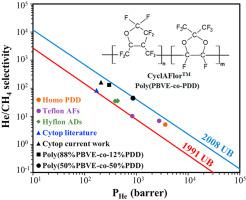Journal of Membrane Science ( IF 8.4 ) Pub Date : 2021-05-12 , DOI: 10.1016/j.memsci.2021.119401
Moataz Ali El-Okazy , Liang Liu , Christopher P. Junk , Erich Kathmann , Whitney White , Sandra E. Kentish

|
Amorphous glassy perfluorinated polymers have high gas permeability, are chemically inert, thermally stable and known for their superior separation performance for several gas pairs. In the current study, the gas separation performance of copolymers of perfluoro(butenyl vinyl ether) (PBVE) and perfluoro(2,2-dimethyl-1,3-dioxole) (PDD) with two different monomer ratios, commercially known as CyclAFlor™, was studied for the first time, both at 35 °C and at higher temperatures below their glass transition temperature. For comparison, the temperature dependence of Cytop® (a homopolymer of PBVE) was studied. The higher the mole percentage of PBVE, the lower gas permeability and the higher selectivity for all gas pairs of interest. All permeability coefficients in Cytop® were lower than those reported in the literature except for helium and hydrogen due to the annealing protocol used, enhancing He/gas and H2/gas selectivity. The poly(PBVE-co-PDD) copolymers exhibited separation performance in the vicinity of the Robeson 2008 upper bound for many gas pairs, including He/H2, He/CH4, He/N2 and N2/CH4. In particular, poly(50%PBVE-co-50%PDD) was more permeable than Hyflon® AD 60 but more selective for most gas pairs of interest. Both copolymers showed increasing H2/CO2 selectivity with temperature. While permeability was stable with pressure up to 10 bar at 35 °C, a change in the activation energy of permeation of CO2 at higher temperatures suggested that changes to the polymer structure had occurred, possibly reducing the glass transition temperature. Mixed gas measurements confirmed the suitability of CyclAFlor™ copolymers for CO2/CH4 separation compared to Cytop®.
中文翻译:

全氟丁烯乙烯基醚与全氟2,2-二甲基-1,3-二恶唑的共聚物的气体分离性能
非晶态玻璃态全氟化聚合物具有高的气体渗透性,化学惰性,热稳定性,并且以其对几种气体对的出色分离性能而闻名。在当前的研究中,全氟(丁烯基乙烯基醚)(PBVE)和全氟(2,2-二甲基-1,3-二恶唑)(PDD)具有两种不同单体比率的共聚物的气体分离性能,商业上称为CyclAFlor™首次在35°C和低于其玻璃化转变温度的高温下进行了研究。为了进行比较,研究了Cytop®(PBVE的均聚物)的温度依赖性。PBVE的摩尔百分比越高,对所有感兴趣的气体对的气体渗透率越低且选择性越高。2 /气体选择性。聚(PBVE-co-PDD)共聚物在Robeson 2008上限附近对许多气体对表现出分离性能,包括He / H 2,He / CH 4,He / N 2和N 2 / CH 4。特别是,聚(50%PBVE-co-50%PDD)比Hyflon®AD 60更具渗透性,但对大多数目标气体对具有更高的选择性。两种共聚物均显示出随温度增加的H 2 / CO 2选择性。虽然在35°C下压力高达10 bar的情况下渗透率是稳定的,但CO 2渗透的活化能发生了变化在较高的温度下,表明发生了聚合物结构的改变,可能降低了玻璃化转变温度。混合气体测量结果证实,与Cytop®相比,CyclAFlor™共聚物适用于CO 2 / CH 4分离。

































 京公网安备 11010802027423号
京公网安备 11010802027423号